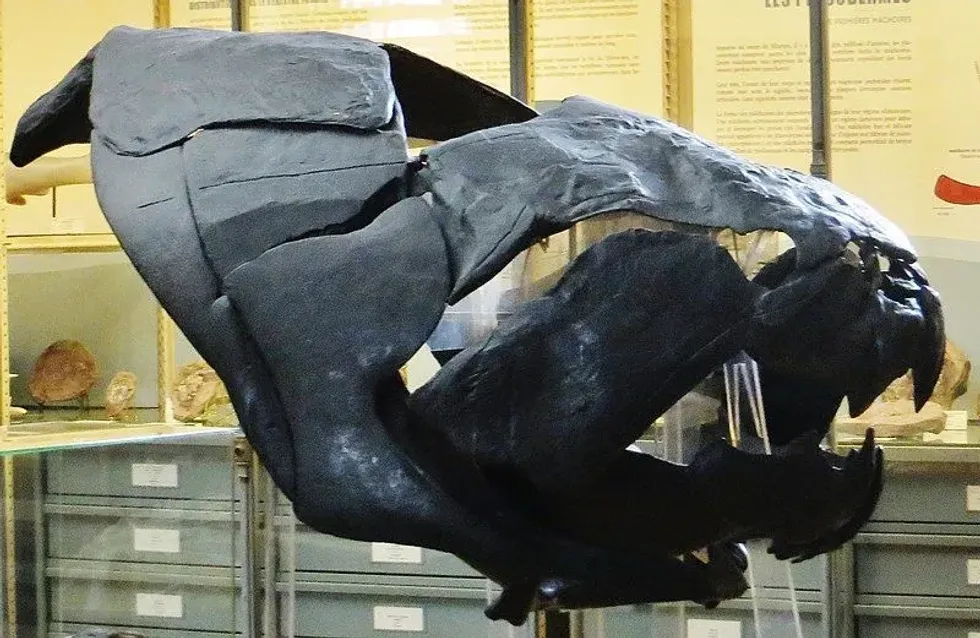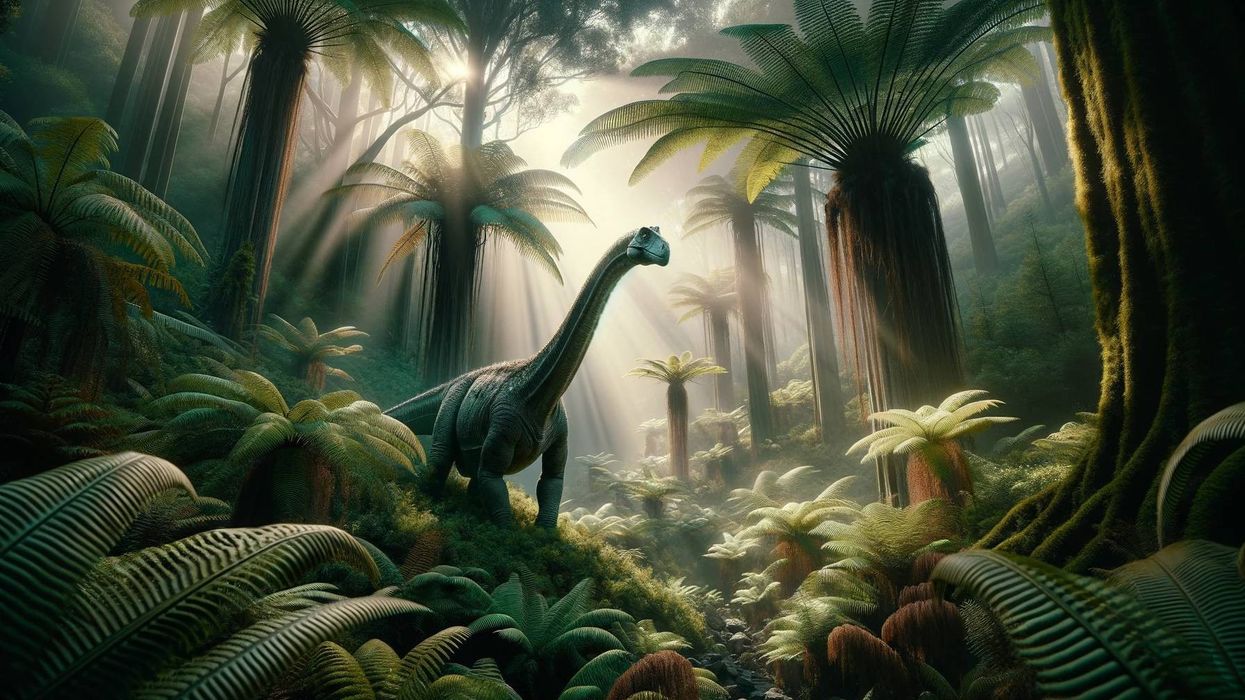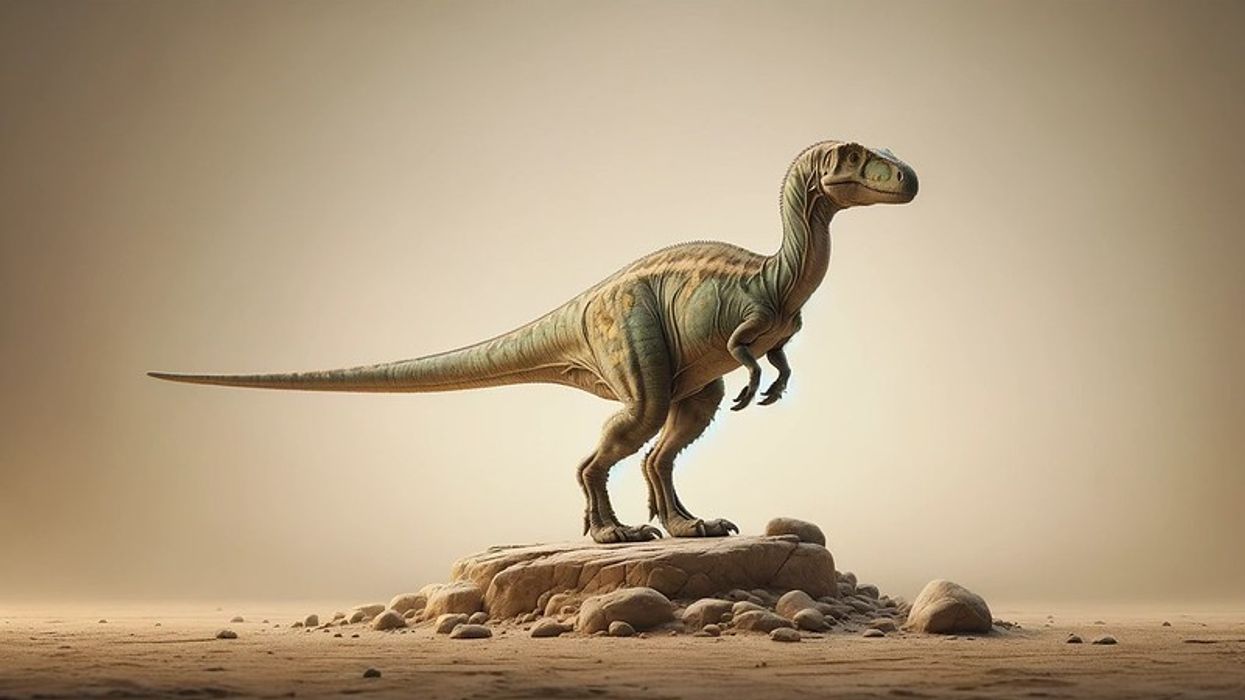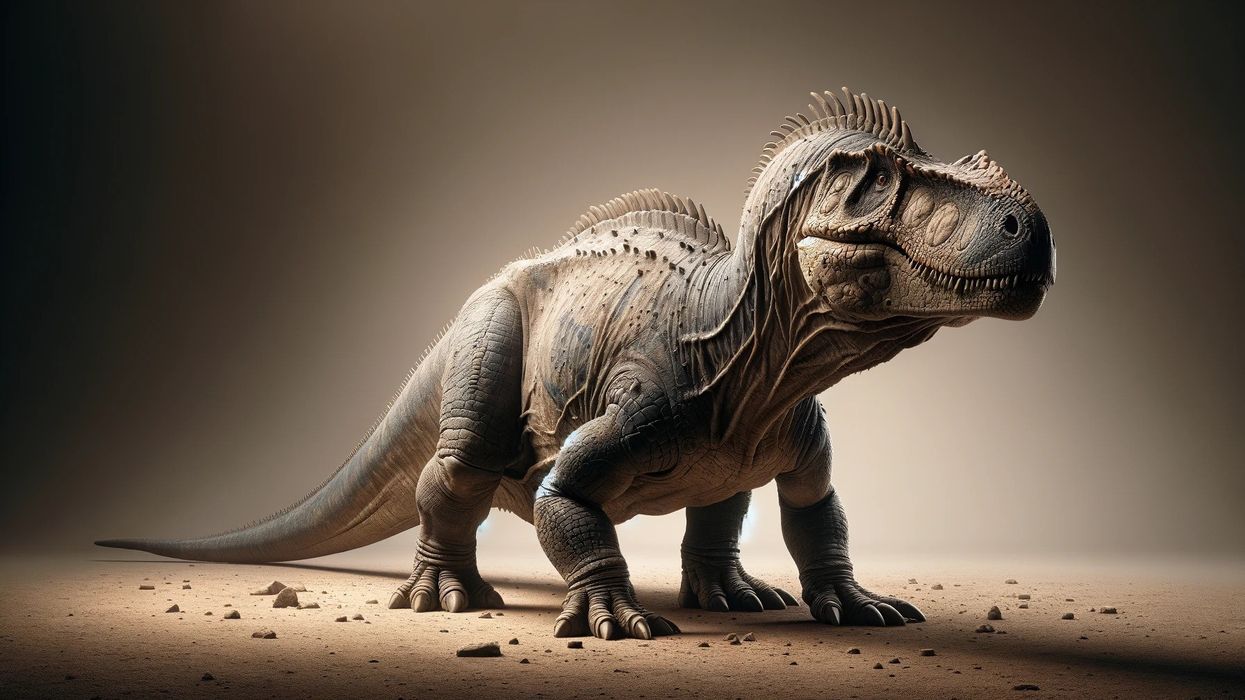The name Dunkleosteus is a composition of two words, the word 'osteon' is a Greek word meaning bone, and Dunkle is kept in the honor of David Dunkle, a famous American paleontologist whose works were focused mainly on fish fossils and is most famous for works in vertebrate paleontology of the Cleveland Museum of Natural History.
This placoderm is known to eat anything or at least most of the things and is also known to be speedy and powerful.
The Dunkleosteus is one of the largest placoderms to have ever lived and is considered to be one of the fiercest in the Late Devonian period which is also known as the ‘Age of Fishes’.
It has been recorded that the Dunkleosteus could weigh up to 8000 lb (3600 kg) and its length was up to 346 in (8.8 m). The Dunkleosteus consists of ten species which are named D. terrelli, D. Belgicus, D. denisoni, D. marsaisi, D. magnificus, D. missouriensis, D. newberryi, D. amblyodoratus, and D.raveri.
The Dunkleosteus placoderms are known to be powerful and possess the ability to move their jaws quickly which helps them prey on animals easily.
Various Dunkleosteus fossils have been found in North America, Morocco, Poland, and Belgium.
The Dunkleosteus comes across as a gripping species but unfortunately, there is limited information available about the species due to its extinction and age as it existed 360-370 million years ago.
Read on to learn about this large prehistoric predator. Discover other fishes with our wels catfish and longhorn cowfish facts.
Dunkleosteus Interesting Facts
What type of animal is a Dunkleosteus?
Dunkleosteus belongs to the placoderm fish category.
What class of animal does a Dunkleosteus belong to?
Dunkleosteus belongs to the class of Placodermi.
How many Dunkleosteus are there in the world?
As the Dunkleosteus is an extinct species, there are no Dunkleosteus left in the world but fossils have been found.
Where does a Dunkleosteus live?
The fossils of the Dunkleosteus have been found in the late Devonian rock units, North America, Europe, and Morocco. Very popular specimens are from Cleveland shale in Ohio. It is also believed that fossils of Dunkleosteus could be found globally.
What is a Dunkleosteus' habitat?
The habitat of a Dunkleosteus is rather unknown but it has been stated that Dunkleosteus was found in shallow seas of the world.
Who do Dunkleosteus live with?
Dunkleosteus were believed to live in shallow oceans with other species of free-swimming marine animals, as Dunkleosteus used to feed on these species.
How long does a Dunkleosteus live?
The lifespan of a Dunkleosteus is unknown but it lived 360-370 million years ago during the Devonian period.
How do they reproduce?
It is believed that there is a high possibility that Dunkleosteus was one of the first animals to reproduce by the method of egg fertilization and thus, reproduce sexually.
What is their conservation status?
The conservation status of the Dunkleosteus is Extinct. The fish is recorded to exist 360-370 million years ago during the Late Devonian period.
Dunkleosteus Fun Facts
What do Dunkleosteus look like?
While not much is known about a lot of parts of the Dunkleosteus body, a lot of information has been extracted from the fossils of Dunkleosteus and its reconstruction. It was discovered that the Dunkleosteus had a two-part bony and armored exterior.
The Dunkleosteus is also known to have two pairs of sharp bony plates that formed a beak-like structure.
Reconstructions have also revealed that some species of the Dunkleosteus had pectoral fins and thus, the fin pattern in the placoderms is highly influenced by the movement requirements. The species Dunkleosteus terrelli is known to have a more shark-like appearance with a strong anterior lobe on its tail.
How cute are they?
The Dunkleosteus was big and powerful, looked like a shark, and was streamlined. It had a strong built and an armor plate around which made it look like a giant violent animal. Therefore, it was scary. It is also considered to be ugly due to its build.
How do they communicate?
The means of communication of Dunkleosteus is unknown as little could be discovered about this from the remains of this predatory fish.
How big is a Dunkleosteus?
The Dunkleosteus is known to be the fiercest fish alive during the Late Devonian period. It is known to be 346 in (8.8 m) long and could weigh up to 8000 lb (3600 kg), which makes it one of the largest placoderms ever lived.
The Dunkleosteus is known for its big and powerful build and is known to have an immense bite force that could chop prehistoric sharks easily.
How fast can a Dunkleosteus swim?
It is believed that Dunkleosteus was not a particularly good swimmer. As it mostly was found in the shallow seas and oceans, their bony structure was sufficient to defend themselves against other creatures in the fish and their availability did not lead Dunkleosteus to go deep into the sea to search for food.
The heavy and bony body with its armor-like bone structure made the Dunkleosteus slow swimmer.
How much does a Dunkleosteus weigh?
A Dunkleosteus is known to be one of the largest species of fish ever lived. They could weigh up to 8000 lb (3600 kg) which makes them bulky animals.
What are their male and female names of the species?
There exist no specific names for the males and females of the species of Dunkleosteus.
What would you call a baby Dunkleosteus?
There is no particular name of a baby Dunkleosteus.
What do they eat?
The Dunkleosteus is known to have used a mechanism called four-bar linkage, which allowed it to open its jaw very fast and produce high bite force when closing the jaw.
The pressure generated helped the Dunkleosteus to cut through any cuticle or dental built or armor. Thus, it is believed that apart from ammonites and other placoderm fish and sharks, and other free-swimming species, they are also known to eat fish from their own species when short of food.
This is supported with evidence of fish bones and other semi or indigested materials found in the fossils.
Are they dangerous?
The Dunkleosteus is considered to be one of the most dangerous sea predators. A lot of factors have been associated with this armored predator which tends to make the Dunkleosteus one of the dangerous placoderms.
Its cannibalistic nature and ability to bend metal are the main reasons. Others include the strong jaw, bite force, pairs of sharp bony plates that make it capable of chopping or cutting hard materials or skins, and the large and strong build.
Would they make a good pet?
As the Dunkleosteus is extinct, there are none left to domesticate. Even if there had been any species of the Dunkleosteus existing, it would have been extremely difficult and almost impossible to keep it as a pet due to various obvious reasons.
Firstly, it would have been highly dangerous to keep this wild fish as a pet, and secondly, it would be difficult to provide the required food and habitat to this predator fish along with huge space.
Did you know...
The Dunkleosteus do not have teeth and instead have two pairs of sharp bony plates that form a beak-like structure and could thus, eat and bend hard structure easily. It is known for its bite force which is around 6000 N and therefore, a Dunkleosteus could eat sharks and members of its own species and other placoderms.
It is believed that this placoderm had a habit of gulping its food down directly and vomiting it out later.
Dunkleosteus terrelli is the largest and the best-known species of the other ten, which is 346 in (8790 mm ) long and possesses a rounded snout. The Dunkleosteus riveri is a small species but is known from an uncrushed skull roof found in a carbonate concretion and so, the Dunkleosteus is known for its thick and bony skull.
It is believed that it had large eyes compared to its body size and so Dunkleosteus skull also became famous.
It has also been discovered that the fossils of Dunkleosteus riveri were below the strata of Dunkleosteus terrelli. Dunkleosteus marsaisi is considered a synonym of the species Dunkleosteus terrelli.
The major Dunkleosteus fossil and specimens are present in Cleveland Museum of Natural History and others include the American Museum of Natural History, National Museum of Natural History, State Museum of Pennsylvania, and Queensland Museum in Brisbane.
Dunkleosteus vs Megalodon
While there are similarities in the appearances between a shark, which is also known as Megalodon, and the Dunkleosteus, there are certain differences. While Megalodon is known to have teeth, the Dunkleosteus do not have teeth.
Megalodons used to go deeper into the sea in search of food, whereas the Dunkleosteus did not go that deep.
While the Dunkleosteus is powerful and known for its size and is said to weigh more than two tons, it was still smaller than the Megalodon. The Megalodons and some other species of it were very large, bigger than the Dunkleosteus size by tons, and thus are the largest prehistoric fish.
How did the Dunkleosteus become extinct?
While there are no specific reasons stated for the Dunkleosteus extinction, there are various speculations that involve climate change and lack of food but one interesting explanation has been given by Thomas Alego of the University of Cincinnati.
According to him, the Devonian sea life was killed by marauding plants and trees. In the Devonian period, the vascular plants flourished.
The roots of these plants penetrated in the ground deeply which broke the rocks.
The breaking of the rocks led to the release of nutrients and minerals, which also got washed off into seas and oceans and could be damaging for marine life.
These nutrients helped in the multiplication of the algae which stained a lot of sea greens. The process used up a lot of oxygen which led to anoxic zones, where there is not enough dissolved oxygen in the water for marine animals to breathe.
This process is a common phenomenon in the current time too and thus, Alego believed these zones could spread to many parts which led to the extinction of the Dunkleosteus and other marine animals in the Devonian period.
Here at Kidadl, we have carefully created lots of interesting family-friendly animal facts for everyone to discover! Learn more about some other fish including goblin shark, or fluke fish.
You can even occupy yourself at home by drawing one on our Dunkleosteus coloring pages.









